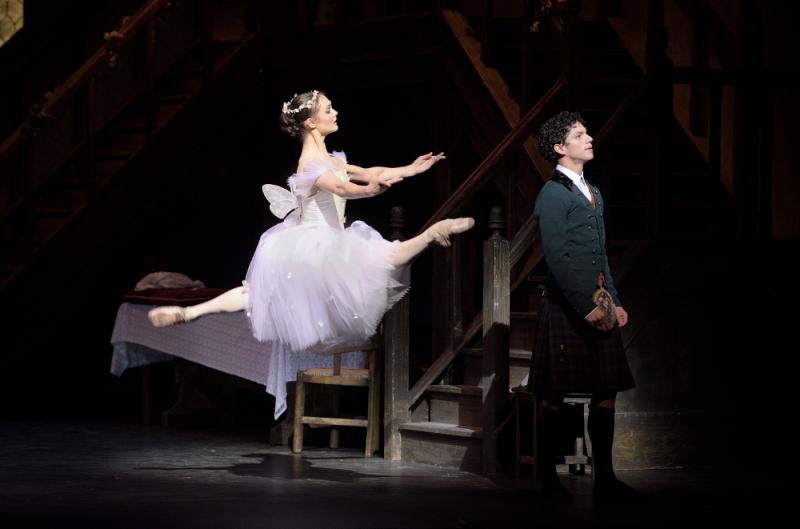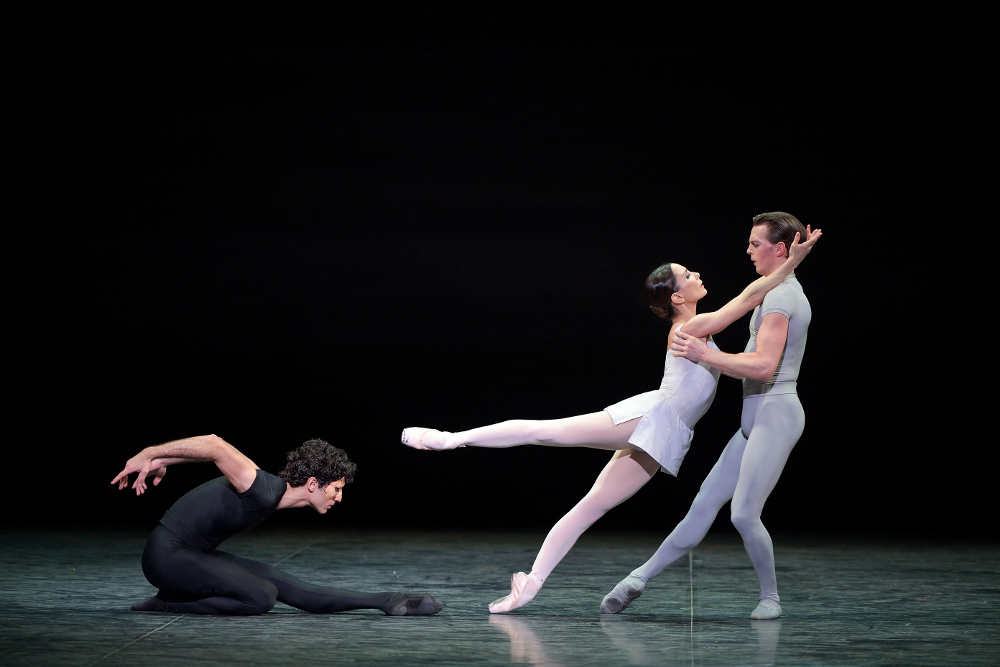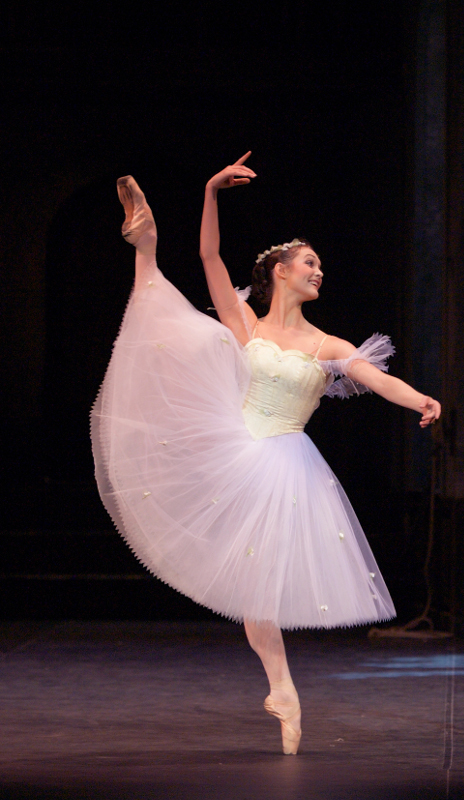Song of the Earth/La Sylphide, English National Ballet review - sincerity and charm in a rewarding double bill | reviews, news & interviews
Song of the Earth/La Sylphide, English National Ballet review - sincerity and charm in a rewarding double bill
Song of the Earth/La Sylphide, English National Ballet review - sincerity and charm in a rewarding double bill
An odd-couple programme delivers both exquisite dancing and emotional truth

The unifying theme of this new Coliseum double bill is death, but don’t let that put you off. Kenneth MacMillan’s Song of the Earth and August Bournonville’s La Sylphide may seem like odd bedfellows, but both are a great deal more uplifting than their plot summaries might suggest, and in the hands of English National Ballet the evening is joyous, even life-affirming.
MacMillan’s Song of the Earth was acquired by the company for its part in the national MacMillan anniversary celebrations last October, and they look at home in it already. Song’s combination of sincerity and levity is a natural fit for the company with its youthful dancers and the glow of purpose and optimism that animates them under Tamara Rojo’s leadership. Freshness fairly reeks from Fernando Carratalá Coloma, who has only just joined the company as an Artist but performed the Messenger of Death on opening night (in place of an injured Aaron Robison) with impressive vigour and precision. A fitting counterpoint to Coloma’s freshness is Rojo herself as the Woman, bringing her worlds of age and experience to bear in playing a character who must confront death. Rojo’s wide, solemn eyes seem to be fixed on a horizon beyond our sight and her every move is deliberate and meditative; where the capers of the supporting dancers give the piece its song, she is its connection to the earth.
There is a certain thematic synergy - young love, the joy of nature, the place of death in all life
Completing the central trio (pictured below) was Joseph Caley as the Man. Caley, who recently joined the company as a principal from Birmingham Royal Ballet, is lithe and tidy, but any attempt at characterisation goes out of the window when he partners Rojo, his face stamped instead with the frantic concentration of a new boy trying desperately not to drop his boss in front of 2,000 onlookers. He could take lessons in tender partnering from James Streeter, whose pas de deux with Tiffany Hedman positively shimmered with happiness; a beautifully tender evocation of young love.That balancing of joie de vivre with a more meditative, resigned mood is one of the particular joys of Song of the Earth, present in the Mahler score (and nicely presented last night in the contrast between Samuel Sakker’s passionate tenor and Rhonda Browne’s serene contralto) and perfectly captured in MacMillan’s choreography. The Sixth Song sees the culmination and unification of both elements, with its central triadic relationship of Man, Woman, Death eventually resolving into the equal light of eternity, and Rojo and company made that as heart-stopping as I’ve ever seen it. The performance of La Sylphide that follows Song is just as shot through with ENB’s now trademark sincerity and charm. Isaac Hernández makes James a wide-eyed hero who lets himself get tempted away from his wedding almost through heedlessness, like a child so intent on chasing butterflies that it doesn’t see a chasm yawning before its feet. Jurgita Dronina’s Sylph is so charming one can understand his fascination: light on her feet and wreathed in smiles, she tempts him with a piquant knowing innocence, fluttering here and there before his disbelieving eyes in all too potent contrast to the quotidien charms of Effy, his sweet, sensible betrothed (Anjuli Hudson).
The performance of La Sylphide that follows Song is just as shot through with ENB’s now trademark sincerity and charm. Isaac Hernández makes James a wide-eyed hero who lets himself get tempted away from his wedding almost through heedlessness, like a child so intent on chasing butterflies that it doesn’t see a chasm yawning before its feet. Jurgita Dronina’s Sylph is so charming one can understand his fascination: light on her feet and wreathed in smiles, she tempts him with a piquant knowing innocence, fluttering here and there before his disbelieving eyes in all too potent contrast to the quotidien charms of Effy, his sweet, sensible betrothed (Anjuli Hudson).
The Bournonville style of La Sylphide is the bel canto of ballet; it may not look like fireworks compared to Don Quixote but it’s still bloody hard. Dronina’s fleet, precise footwork and perfectly inclined head are a joy to a ballet geek’s heart, while her mime should be a joy to everyone, not only for its entirely believable emotion, but for the tiny details that make her a sylph through and through (my favourite was when, having caught an imaginary moth in Act II, her cupped hands quivered almost unconsciously as if really tickled by a struggling insect). (Pictured below right: Dronina as the Sylph)
 The simple, mechanical stage-trickery that makes the sylph “magically” appear and disappear in Mikael Melbye’s plain but evocative Scots baronial set is intensely satisfying: in these days of limitless digital possibility it’s somehow all the more pleasurable to see an actor whisked up a chimney by invisible, but clearly human, means. The witch trickery of the plot, with Madge (Jane Haworth, satisfyingly hammy) cursing and engineering the downfall of poor James, is rather heavy-handed; the corps of sylphs, impeccably together in the Romantic style (props to both dancers and coaches) are a much more effective enchantment. One sympathises with James’s shock when first confronted with the sylphs en masse: they may not be as terrifying as Giselle’s wilis, but they are quite fey enough to evoke the uncanny.
The simple, mechanical stage-trickery that makes the sylph “magically” appear and disappear in Mikael Melbye’s plain but evocative Scots baronial set is intensely satisfying: in these days of limitless digital possibility it’s somehow all the more pleasurable to see an actor whisked up a chimney by invisible, but clearly human, means. The witch trickery of the plot, with Madge (Jane Haworth, satisfyingly hammy) cursing and engineering the downfall of poor James, is rather heavy-handed; the corps of sylphs, impeccably together in the Romantic style (props to both dancers and coaches) are a much more effective enchantment. One sympathises with James’s shock when first confronted with the sylphs en masse: they may not be as terrifying as Giselle’s wilis, but they are quite fey enough to evoke the uncanny.
With its shortbread-tin Scottish setting and rather ordinary human characters, Sylphide can seen like a poor cousin to the exquisite tragedy of Giselle, but done well, as it is by ENB, it is a treasure of a ballet, not only for its historical importance – there’s no Giselle without Sylphide, after all, and the perfect preservation of its Romantic choreography since 1836 is remarkable – but also as a highly effective fairy tale. Where the later ballet meditates discomfortingly on femininity and power, the earlier one presents a tug-of-war between nature and society that is the quintessential stuff of folklore, and in a way much less reassuring. Giselle, after all, ends with reconciliation of a kind, and a live if chastened hero; in Sylphide the hapless James will not be rescued from the consequences of his transgression on natural and social norms.
It is undeniably an odd pairing, this Romantic gem and MacMillan's unmistakably 20th century elegy, but it works. Partly because there is a certain thematic synergy between the two – young love, the joy of nature, the place of death in all life – but mostly because ENB are totally dedicated to bringing out the emotional truth of both pieces, as well as to music and dancing of the highest standard. It may not be an obvious night at the ballet, but it's all the more rewarding for it.
rating
Share this article
The future of Arts Journalism
You can stop theartsdesk.com closing!
We urgently need financing to survive. Our fundraising drive has thus far raised £49,000 but we need to reach £100,000 or we will be forced to close. Please contribute here: https://gofund.me/c3f6033d
And if you can forward this information to anyone who might assist, we’d be grateful.

Subscribe to theartsdesk.com
Thank you for continuing to read our work on theartsdesk.com. For unlimited access to every article in its entirety, including our archive of more than 15,000 pieces, we're asking for £5 per month or £40 per year. We feel it's a very good deal, and hope you do too.
To take a subscription now simply click here.
And if you're looking for that extra gift for a friend or family member, why not treat them to a theartsdesk.com gift subscription?
more Dance
 'We are bowled over!' Thank you for your messages of love and support
Much-appreciated words of commendation from readers and the cultural community
'We are bowled over!' Thank you for your messages of love and support
Much-appreciated words of commendation from readers and the cultural community
 R:Evolution, English National Ballet, Sadler's Wells review - a vibrant survey of ballet in four acts
ENB set the bar high with this mixed bill, but they meet its challenges thrillingly
R:Evolution, English National Ballet, Sadler's Wells review - a vibrant survey of ballet in four acts
ENB set the bar high with this mixed bill, but they meet its challenges thrillingly
 Like Water for Chocolate, Royal Ballet review - splendid dancing and sets, but there's too much plot
Christopher Wheeldon's version looks great but is too muddling to connect with fully
Like Water for Chocolate, Royal Ballet review - splendid dancing and sets, but there's too much plot
Christopher Wheeldon's version looks great but is too muddling to connect with fully
 iD-Reloaded, Cirque Éloize, Marlowe Theatre, Canterbury review - attitude, energy and invention
A riotous blend of urban dance music, hip hop and contemporary circus
iD-Reloaded, Cirque Éloize, Marlowe Theatre, Canterbury review - attitude, energy and invention
A riotous blend of urban dance music, hip hop and contemporary circus
 How to be a Dancer in 72,000 Easy Lessons, Teaċ Daṁsa review - a riveting account of a life in dance
Michael Keegan-Dolan's unique hybrid of physical theatre and comic monologue
How to be a Dancer in 72,000 Easy Lessons, Teaċ Daṁsa review - a riveting account of a life in dance
Michael Keegan-Dolan's unique hybrid of physical theatre and comic monologue
 A Single Man, Linbury Theatre review - an anatomy of melancholy, with breaks in the clouds
Ed Watson and Jonathan Goddard are extraordinary in Jonathan Watkins' dance theatre adaptation of Isherwood's novel
A Single Man, Linbury Theatre review - an anatomy of melancholy, with breaks in the clouds
Ed Watson and Jonathan Goddard are extraordinary in Jonathan Watkins' dance theatre adaptation of Isherwood's novel
 Peaky Blinders: The Redemption of Thomas Shelby, Rambert, Sadler's Wells review - exciting dancing, if you can see it
Six TV series reduced to 100 minutes' dance time doesn't quite compute
Peaky Blinders: The Redemption of Thomas Shelby, Rambert, Sadler's Wells review - exciting dancing, if you can see it
Six TV series reduced to 100 minutes' dance time doesn't quite compute
 Giselle, National Ballet of Japan review - return of a classic, refreshed and impeccably danced
First visit by Miyako Yoshida's company leaves you wanting more
Giselle, National Ballet of Japan review - return of a classic, refreshed and impeccably danced
First visit by Miyako Yoshida's company leaves you wanting more
 Quadrophenia, Sadler's Wells review - missed opportunity to give new stage life to a Who classic
The brilliant cast need a tighter score and a stronger narrative
Quadrophenia, Sadler's Wells review - missed opportunity to give new stage life to a Who classic
The brilliant cast need a tighter score and a stronger narrative
 The Midnight Bell, Sadler's Wells review - a first reprise for one of Matthew Bourne's most compelling shows to date
The after-hours lives of the sad and lonely are drawn with compassion, originality and skill
The Midnight Bell, Sadler's Wells review - a first reprise for one of Matthew Bourne's most compelling shows to date
The after-hours lives of the sad and lonely are drawn with compassion, originality and skill
 Ballet to Broadway: Wheeldon Works, Royal Ballet review - the impressive range and reach of Christopher Wheeldon's craft
The title says it: as dancemaker, as creative magnet, the man clearly works his socks off
Ballet to Broadway: Wheeldon Works, Royal Ballet review - the impressive range and reach of Christopher Wheeldon's craft
The title says it: as dancemaker, as creative magnet, the man clearly works his socks off
 The Forsythe Programme, English National Ballet review - brains, beauty and bravura
Once again the veteran choreographer and maverick William Forsythe raises ENB's game
The Forsythe Programme, English National Ballet review - brains, beauty and bravura
Once again the veteran choreographer and maverick William Forsythe raises ENB's game

Add comment